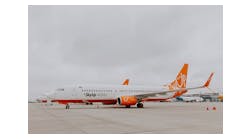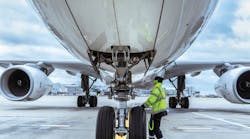During the first Gulf War in the early 1990s, airports found themselves in a predicament.
Passengers were interested in learning more about the events going on overseas, but found themselves isolated from the rest of the world while waiting for their flights inside of terminals.
At the time Deborah Cooper was with Airports Council International (ACI), when she was contacted by CNN in finding a way to fill this demand.
Cooper came on board and the network launched the CNN Airport Network. What started out in a handful of airports has boomed into more than 250 million viewers at 49 U.S. airports in the past 25 years.
Cooper, who is president of CNN Airport Network, took the time to speak with Airport Business and tell us how the network has evolved and what airports could be in store for airport entertainment in the near future.
AB: Can you tell me a little bit on how you’ve seen the market change for the network?
Cooper: CNN Airport Network started out as a 30-minute wheel with its own dedicated anchors. We launched with five pilot airports: Cincinnati, Miami, DFW, MSP and Dulles in 1991. Ted Turner was concerned that as the war drew to a close, travelers might lose interest in programming. Research showed us that not only were travelers interested in the news, but they also wanted to see stock market information, weather, sports and other feature pieces. Our service evolved from the 30-minute wheel to a one hour and then a two hour loop. Three years later, we launched a live service. And now we’re a live service that has gone from being predominantly news to featuring about 35 percent news and weather, 25 percent live sports, 15 percent lifestyle, 15 percent travel and then 10 percent local and regional content. So CNN Airport Network has evolved significantly.
AB: Can you tell me how CNN Airport Network looks at competing or complementing the mobile devices given how that has changed the makeup of the gate area?
Cooper: Our research has shown us that people are at the gate for an average of 90 minutes and that they are watching Airport Network for about 53 minutes. Does that mean they’re watching intently for that full 53 minutes? No, but, if they’re sitting in a viewing zone, they’re hearing the audio even though they’re engaged with their devices—they may be on their computer, their phone or reading a magazine—but when something of interest is introduced, they look up and they watch. We find that there is a complementary relationship. Plus, if there’s a story on Airport Network that they want to know more about, they can dig deeper into CNN.com and get more on that story. In addition, we launched a partnership with Tunity which is a free app that enables viewers to sync our audio through their headphones enabling them to have the visual and crystal clear synchronized audio.
AB: Can you tell me about what it is that’s driving the content and the research you do reach passengers on a monthly basis or weekly basis?
Cooper: We conduct a bi-annual Nielsen study to determine what passengers want to see on our screens. When I say determine, after 25 years of programming for the traveler on the go, we know what travelers want during their time at the airport. As news is the number one genre of programming that travelers want during their travel day, we air New Day and Morning Express with the ever popular Robin Meade in the early hours. This is followed by MicheaLA out of our LA office. Feature pieces, whether it be Anthony Bourdain or Morgan Spurlock, are really popular mid-day. We have custom pieces that are produced by Airport Network, which include guides to gorgeous destinations all around the world as well as things to do at airports. Who doesn’t want to sit in a gate and dream about their next vacation? We have travel tips for frequent flyers, how to stay fit when you’re on the road, highlights to the latest trends at airports around the country so when they’re traveling they know there’s a putting green here, there’s a spa there, you can get your nails done in Atlanta on concourse X. At 4 p.m. we go to Jake Tapper, Wolf Blitzer, Erin Burnett, Anderson Cooper and Don Lemon. Then in the overnight hours we air CNN International.
AB: Your network does a lot to respond with social media. Can you tell me a little about how that works and how you’re looking to engage the audience to build or create content?
Cooper: As we discussed earlier, everyone travels with personal devices so we tap into that energy and opportunity. We catalogue all the tweets that we get about our programming. Lots of thumbs up when there are live sporting events. We air NFL games, the Super Bowl, NBA and the NCAA. I love this particular tweet that says “flight is delayed, riots averted we’re all watching the Carbonaro Effect on CNN Airport Network.” We have introduced entertainment pieces from TBS including custom pieces from Conan, TruTV the Carbonaro Effect and lots of other fun segments. We focus on family-friendly programming. You can have children and grandparents and we want to be sure that everyone is informed and entertained.
AB: Can you tell me what the airports are asking from your network and the service you’re delivering?
Cooper: Airports really want to keep their passengers informed and entertained. They also like the idea of giving the passenger a flavor of their city or region, including restaurants, local activities, events and landmarks. Airports have up to six minutes of local time every hour where they can promote themselves, the city and the region. I think using that local time is a way for the airports to convey the sense of place - what that city, town or region is all about. We’ve found now that about 26 airports currently use their time to promote themselves, their concessions and their communities.
AB: Looking at where you now and where you want to be for the future, are there any areas you really want to see the service grow or improve from where it is today?
Cooper: I think the interesting thing is that technology is always evolving. We have gone from bicycling tapes to airports in 1991 to satellite delivery of content and now to IP delivery. With IP delivery, there are myriad of things that can be accomplished - whether it’s delivering specific information to a gate hold area or enabling interactivity through the TV. I think that’s an area that excites and challenges us. With our WiFi partner Boingo in Miami, we’re delivering a version of CNN in Español because 65 percent of their travelers are Spanish speaking. While we can promote that on airport network it is a WiFi delivered service that allows Spanish speaking people to enjoy our Spanish programming. We have the ability to develop custom channels to satisfy diverse interests.
AB: Given the different technologies out there how do you decide what to go with when installing in a new airport or improving service at an existing airport installation?
Cooper: You can imagine the engineering staff we have here at CNN. It’s called BEST. They really are the best in researching and determining which technologies to go with. Just like an airport, whenever there’s an opportunity to upgrade or install new technologies, BEST engineering will help us determine who is most qualified to handle our projects. In addition, we are looking at the international arena because, as you’re aware, CNN is a global brand and well respected around the world.
AB: Can you tell me when it comes to programming what it is that the network will be delivering in the next 10-20 years?
Cooper: We are always looking for ways to reinvent ourselves. We’re looking at how we can become more interactive. Is there a way, perhaps with beacon technology, that we can deliver more data about how to get the information that you really want as a traveler, whether it’s about a news story or a destination, a restaurant or places to visit. How will that interactive technology work? That’s the kind of thing we’re looking into. When we aired the CNN quiz show, we noticed people looking up and trying to beat the experts. Well, how would we go about making that an interactive opportunity where they really would be playing with Anderson Cooper and Jake Tapper? That would be of interest.
AB: What do you think CNN Network has done to contribute to the overall airport experience and for passengers?
Cooper: I think it’s all about connectivity. How do you help the traveler feel that their dwell time at an airport is productive and filled with opportunity to connect with what’s going on in the world. The idea that airports are there to make connections to other cities, countries and people is key and we support that by providing the connection to information of interest before you get on your plane. That’s why this service came from passenger demand. Passengers felt isolated in their gates and wanted to connect with things that were important to them—world events, domestic events, weather, the stock market, sports updates. Let’s face it, airports are all about connection.
AB: Outside of the technology aspect, is there anything on the near horizon in the near future for new types of programming?
Cooper: We’re always looking at new programming and CNN is always creating new programming. Great Big Story, which launched last year, is a digital-only platform with videos that are not about cute kittens, puppies and listicles. They are stories that are largely untold, exquisitely shot and produced. We recently have included GBS in our programming and it has been extremely popular. We’re always on the lookout for new programming opportunities and we are fortunate to have the vast resources of Time Warner, Turner and CNN behind us.





